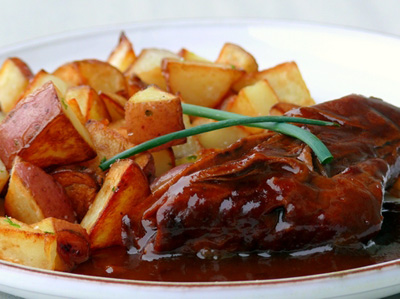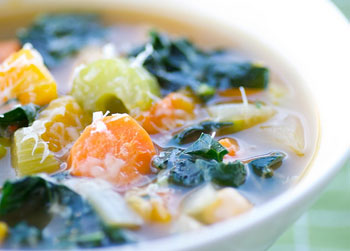 Kale is in season right now with the common curly kind leading the pack. But there's also a darker, more unique variety that hails from Italy. Tuscan kale is darker in color, more delicate in flavor, and tender to eat. It's especially great in salads and it holds up to many bold flavors. If you're craving a salad this winter, Tuscan kale should be your green of choice.
Kale is in season right now with the common curly kind leading the pack. But there's also a darker, more unique variety that hails from Italy. Tuscan kale is darker in color, more delicate in flavor, and tender to eat. It's especially great in salads and it holds up to many bold flavors. If you're craving a salad this winter, Tuscan kale should be your green of choice.
Most people only think of kale as a cooked vegetable, but kale is great raw. Not only do you benefit from all its vitamins when it's raw, you also get a great texture and fresh taste. It's great as a slaw, or as an appetizer or main course salad. For this hearty recipe, I combine kale with sautéed mushrooms, croutons, and a richly flavored brown butter vinaigrette. I top it off with Parmesan and a poached egg. Serve it for lunch or a light dinner with a glass of wine.

 Do you ever look at chestnuts at this time of year and wonder what to do with them besides add them to stuffing? When I was a kid we used to simply roast them over the fire and they were fun to eat.
Do you ever look at chestnuts at this time of year and wonder what to do with them besides add them to stuffing? When I was a kid we used to simply roast them over the fire and they were fun to eat. Brisket....I'm licking my lips. I love it. I've always loved it...as long as it's cooked right. Let's face it, it's a tough, flat piece of meat. It's a chest muscle. The only way to cook it right, is low and slow...which is why we braise. And the Guinness adds a nice layer of deep complexity to the sauce, just like red wine does to a pot roast. However, since the barley used to make Guinness is roasted, you get this really deep flavor in dished like this.
Brisket....I'm licking my lips. I love it. I've always loved it...as long as it's cooked right. Let's face it, it's a tough, flat piece of meat. It's a chest muscle. The only way to cook it right, is low and slow...which is why we braise. And the Guinness adds a nice layer of deep complexity to the sauce, just like red wine does to a pot roast. However, since the barley used to make Guinness is roasted, you get this really deep flavor in dished like this. New Year's resolutions. They're nothing but bunkum.
New Year's resolutions. They're nothing but bunkum. Some drinks are just good. Some drinks are good stories with provenance. Some drinks are all the above!
Some drinks are just good. Some drinks are good stories with provenance. Some drinks are all the above!
